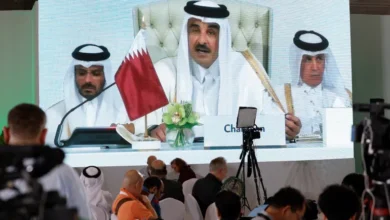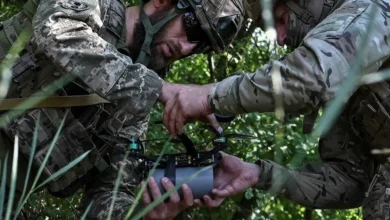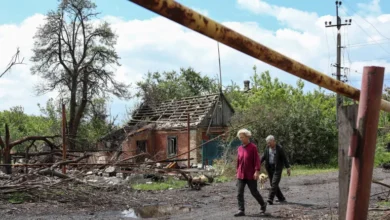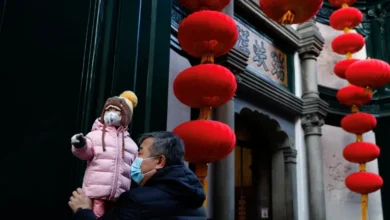The beekeepers of Sine Saloum: How all-women team tends to Senegal mangrove

Clutching a purse and clad from head to toe in white protective gear, Bintou Sonko removes a small metal kettle from her purse and releases smoke into one of the 50 beehives nestled in the dense mangrove outside her town in Senegal. Pacifying the bees, the 53-year-old extracts a dark golden liquid from within.
In 2022, she, her sister, and several others in the 67-strong women’s cooperative in Joal-Fadiouth, a town 100km (62 miles) south of Dakar, spent a month learning how to make honey, build hives and interact calmly with the bees. Despite an initial fear of being stung, she is in no doubt of their importance in the mangrove.
For Sonko and her colleagues who have long been shellfish gatherers, their newfound occupation as beekeepers provides additional income. But as climate change and deforestation threaten the mangrove, many say beekeeping is good for the invaluable biodiversity haven and carbon sink that stores up to five times more carbon than tropical rainforests.
“Bees and honey protect the mangrove,” says Sonko, president of the cooperative Mboga Yaye, which means “a good Serrer” in the local language of the Serrers, the main ethnicity in the mangrove-rich delta of Sine Saloum. The delta was named a UNESCO World Heritage Site in 2011.
Sonko explains that the bees pollinate the mangrove forest, creating more habitat for fish, shellfish and shrimp that the women traditionally collect. But more importantly, she says, “it allows the mangrove to rest”.
For millennia, collecting oysters and other molluscs has been the mode de vie for women in the mangroves. Mountains of empty shells make up burial sites in the town’s cemetery and adorn the cemented walls of houses and pavements. But a changing climate and growing population are forcing the women to innovate.
The UN agency for food and agriculture, FAO, said in a January 2023 report that drought, increased salinity of the mangroves, and overfishing mean that the volumes of oysters harvested in Senegal are falling, although exact figures are hard to find due to the informal nature of the work.
Richard Dacosta, marine expert at environmental communications non-profit GRID-Arendal agrees. He says the impact of climate change is contributing to a degrading mangrove ecosystem and affecting communities like Mboga Yaye.
“A degrading mangrove means you degrade the nursery habitat for fish, shrimp, and shellfish,” Dacosta told Al Jazeera, highlighting that Senegal has lost 30 percent of its mangrove area since 1950. “Oyster gatherers are having to spend double the time in the mangrove for half the return.”
That impact and Joal-Fadiouth’s population doubling from 28,000 to 54,000 since 2000 could have led to a decimation of the shellfish stocks, the mangrove, and their livelihoods like in many other parts of Senegal. Instead, Mboga Yaye, with the support of local environmental NGO Nebeday, is pioneering a management approach that conserves mangrove resources and boosts their income.
Mangrove innovations
As well as gathering and selling shellfish, the entrepreneurial cooperative has other entrepreneurial activities; they process shellfish into ready-to-eat sauces; produce honey, jams, juices, soap and snacks; and manufacture ecological stoves and biocarbon. They have also built a shop and restaurant where they sell these products to their community and visiting tourists.
According to Sonko, selling directly to consumers “enhances the value” of their products so that they can earn more from less and become more resilient to a changing climate. She explains that by selling honey through the shop and to hotels, they make 10,000 CFA francs ($16.50) per kg. This year, they harvested 290kg (639lb) of the salty-sweet honey, bringing in almost $5,000 of additional income.
Thanks to the restaurant and the shop, members sell the shellfish they gather in the mangrove directly to the cooperative where they are sold fresh or in sauces, fetching a much higher price than if they were dried and sold on the regular market. Bintou estimates that women can make as much as 20,000 CFA francs ($33) a day, compared to 5,000 CFA francs ($8) previously.
“Thinking of our future and protecting the mangrove has forced us to find new sources of income,” says Sonko.
Mariama Diallo, ecologist and researcher at University Cheikh Hamidou Kane in Dakar says the key to Mboga Yaye’s success is “balancing the needs of the individual with the collective”.
She calls this a “fine line” where the women can meet their economic needs but also sustainably manage mangrove resources, by collectively enforcing quotas and periods of rest when the shellfish are reproducing. As such, members can collect and sell shellfish to the cooperative a maximum of 15 days a month for their own income, but each has to contribute to the collective’s activities like honey harvesting and managing the shop, the revenue of which goes to the cooperative.
The motivation to adapt for many of the women is clear, as Sonko explains that 25 of the members including herself, are widows and the sole breadwinners for their families and children. “I have no husband, no mother, no father – I don’t expect anything from anyone – we have to work,” says Sonko, a mother of eight.
Solidarity and social security are built into the structure of the cooperative. Last year it split the profit of 1.2 million CFA francs ($2,000) equally among them, but only after paying school fees for the members’ children and offering microloans to women who want to start their own ventures too small to ask a bank.
“Mboga Yaye is a family,” says Sonko. “Every October, when school starts, we distribute money to all the women to help pay for the children’s school fees.”
Ecologist Diallo calls this model “a powerful lever for the whole community” as women in Senegal are generally responsible for education.
But it is not entirely a smooth ride: Mboga Yaye still faces the challenge of inflation; higher costs of running the business as well as increased needs of its members due to a rising cost of living.
Despite this, the cooperative is being held up as an example for other communities to follow. Nebeday has supported Sonko and the cooperative to travel around the country and lead workshops on their creative approach to mangrove management.
This peer-to-peer learning model is yielding results because communities trust and respect the experience of Sonko and Mboga Yaye, rather than a specialist trainer who does not know their reality, explains Nebeday coordinator in Joal-Fadiouth, Elizabeth Tambedou.
“With the women from Mboga Yaye, within two minutes they understand,” says Tambedou.
Local solution, global impact
In a policy brief presented at COP28 last year, a group of experts at the French National Research Institute for International Development proposed working with and empowering Indigenous communities like Mboga Yaye to sustainably manage and restore mangroves. They praised the model as a more effective and sustainable solution than large-scale carbon offsets, mired in human rights controversies and unreliable models that allow companies to continue polluting.
Back at the cooperative, the sun sets over the bustling processing site. Oysters are laid out in the driers as some women shuck and sort today’s catches while others clean the protective beekeeping gear thick with clay from the mudflats.
Sonko, who works 12-hour days overseeing the 10 different enterprises, reveals that her ultimate ambition is to create an education and training centre for women across Senegal to learn from their experiences.
“I want to help women be independent and protect our mangrove – if there is no mangrove, there is no honey, no oysters, no fish – no income,” she says.










